Centauri Dreams
Imagining and Planning Interstellar Exploration
Voyager 2: Digging Deeper into the Data from Uranus
Voyager 2’s flyby of Uranus and its moons occurred on January 24, 1986, returning images that for many of us will always be associated with the outpouring of grief over the loss of Challenger, which occurred a scant four days later. But Voyager’s data were voluminous, its images striking, as we examined the ice giant and its unusual moons up close. The spacecraft closed to 81,500 kilometers of the cloud tops, examining the ring system and discovering 11 new moons.
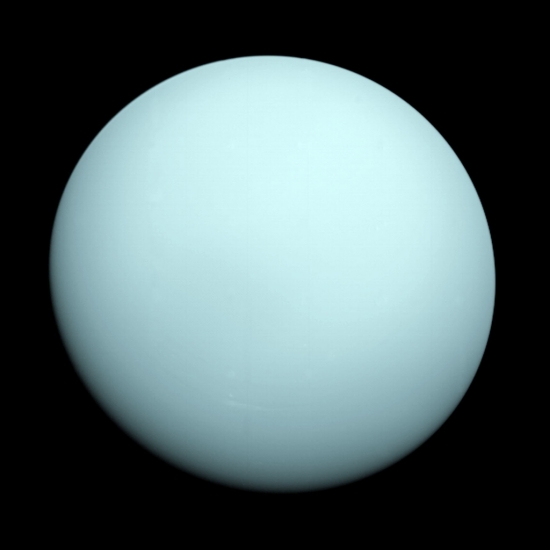
Image: The planet Uranus, in an image taken by the spacecraft Voyager 2 in 1986. The Voyager project is managed for NASA by the Jet Propulsion Laboratory. Credit: NASA/JPL-Caltech.
Uranus was already known from early analysis of the Voyager data to have an odd magnetosphere, created where solar wind plasma interacts with the planet’s magnetic field. The planet spins on its side, and its magnetic field axis is tilted 60 degrees away from its spin axis, producing a magnetosphere that wobbles in ways that researchers liken to a poorly thrown American football. Modeling a magnetosphere like this is no easy task, but we’d like to know more because these interactions with the solar wind affect local space and the circulation of plasma, with a known effect on atmospheric plasma escape.
Now we learn from a new paper taking a deeper look at the Voyager magnetometer data that the spacecraft’s passage past Uranus took it through a type of magnetic ‘bubble’ called a plasmoid, one that needs to be factored into our understanding of the planet’s magnetic environment. The paper calls plasmoids ‘helical bundle[s] of magnetic flux’ that pinch off the end of a planet’s magnetotail, as the magnetosphere is shaped and pushed by the Sun.
To turn up the plasmoid, a phenomenon little studied at the time of the flyby, authors Gina DiBraccio and Dan Gershman, both at Goddard Space Flight Center, fine-tuned the analysis of the magnetometer data by plotting new datapoints every 1.92 seconds. What they found was a quick blip that occupied 60 seconds out of a total 45-hour flyby, but it revealed a plasmoid believed to consist mostly of ionized hydrogen some 200,000 kilometers long and 400,000 kilometers across.
Plasmoids are interesting here and elsewhere because by drawing ions out of a planet’s atmosphere, they alter its composition. They’ve shown up from Mercury to Saturn and have been observed at Earth, but this is the first time one has been identified at Uranus. The smooth, closed magnetic loops the scientists found are characteristic of plasmoids formed as a rotating planet loses atmosphere to space. Says Gershman: “Centrifugal forces take over, and the plasmoid pinches off.”
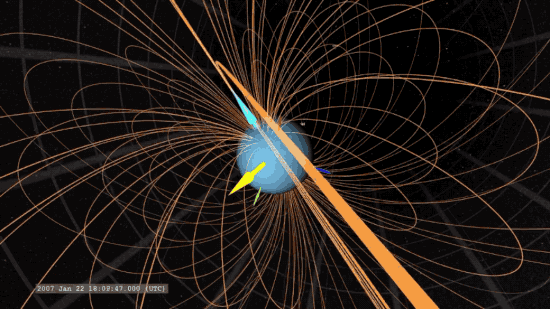
Image: An animated GIF showing Uranus’ magnetic field. The yellow arrow points to the Sun, the light blue arrow marks Uranus’ magnetic axis, and the dark blue arrow marks Uranus’ rotation axis. Credit: NASA/Scientific Visualization Studio/Tom Bridgman.
This is the first observation of a plasmoid in an ice giant magnetosphere. Should we expect the same thing to occur at Neptune? From the paper:
Although no relevant measurements are available for Neptune due to the 1989 Voyager 2 flyby trajectory [Stone and Miner, 1989], we suggest that its systematic mass loss may include a significant plasmoid contribution as well. Similar to Uranus, Neptune’s magnetosphere exhibits a large variance between the rotation and magnetic axes at an angle of ~47. However, in contrast to Uranus, Neptune’s rotation axis is not aligned with the solar wind (~30 inclination). This difference may allow for internal effects to play a larger role in mass loss and overall plasma convection. For this reason, unlike at other magnetospheres throughout the solar system, the planet’s rotation and solar wind forcing may have nearly equal contributions to the energy and plasma input at Uranus and Neptune.
It’s clear that circulation within the magnetosphere and the processes of atmospheric loss are major topics for both of our ice giants, leading the authors to note the importance of new in situ measurements “to definitively determine the relative contributions of planetary rotation and solar wind forcing in driving global plasma dynamics…” For now, the ice giants remain mysterious, revealing themselves only through our single Voyager flyby.
The paper is DiBraccio and Gershman, “Voyager 2 constraints on plasmoid?based transport at Uranus,” Geophysical Research Letters 9 August 2020 (abstract).

The 1000 AU Target
One reason I wanted to run yesterday’s article about the Opher et al. paper on the heliosphere, aside from its innate scientific interest (and it is a very solid, well crafted piece of work) is to illustrate how much we still have to learn about the balloon-like bubble carved out by the solar wind. The entire Solar System fits within it easily, but we observe only from inside and have little knowledge of its structure. None of the paper’s authors would argue that we have the definitive answer on the shape of the heliosphere. That will take a good deal more data, as the paper notes:
Future remote-sensing and in situ measurements will be able to test the reality of a rounder heliosphere. In Fig. 6, we show our prediction for the interstellar magnetic field ahead of the heliosphere at V2. In addition, future missions such as the Interstellar Mapping and Acceleration Probe will return ENA [energetic neutral atom] maps at higher energies than present missions and so will be able to explore ENAs coming from deep into the heliospheric tail. Thus, further exploration of the global structure of the heliosphere will be forthcoming and will put our model to the test.
We’ll learn more from the Voyagers, in other words, as well as from IMAP (more about this one in a later article), New Horizons, and whatever probe we next send out to system’s edge. Our two Voyager spacecraft may well last another seven years, which would give them 50 years of data return since their launch in 1977.
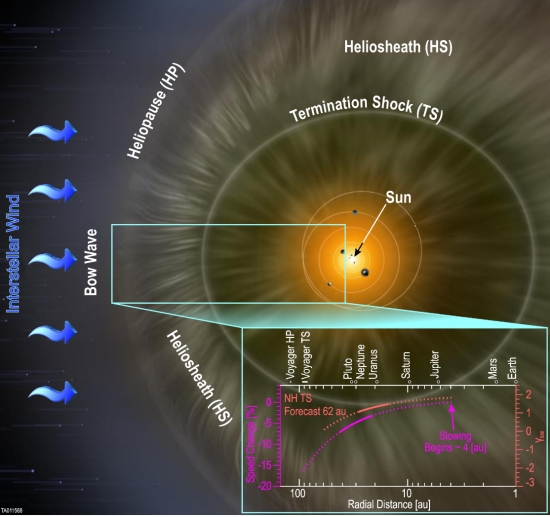
Image: And here’s something we’ve learned from New Horizons. The SWAP instrument aboard the spacecraft has confirmed that the solar wind slows as it travels farther from the Sun. This schematic of the heliosphere shows the solar wind begins slowing at approximately 4 AU radial distance from the Sun and continues to slow as it moves toward the outer solar system and picks up interstellar material. Current extrapolations reveal the termination shock may currently be closer than found by the Voyager spacecraft. However, increasing solar activity will soon expand the heliosphere and push the termination shock farther out, possibly to the 84-94 AU range encountered by the Voyager spacecraft. Credit: Southwest Research Institute; background artist rendering by NASA and Adler Planetarium.
The interstellar probe NASA has been contemplating, under study at various centers but most visibly at the Johns Hopkins Applied Physics Laboratory (APL) would, unlike Voyager, be built from the start with a 50 year goal in mind. Voyager 1 is now about 141 AU from Earth (21.2 billion kilometers). Interstellar Probe (APL capitalizes its design) would go for 1000 AU, but at much improved speeds, reaching the distance in 50 years.
How to do this? For one thing, achieve a boost from one of the huge rockets now coming onto the market, perhaps NASA’s own Space Launch System (SLS), or a commercial entry from a private company, perhaps SpaceX or Blue Origin. We’re not talking about launching until 2030, and that’s assuming the mission gets the green light in the upcoming heliophysics decadal survey, which will put in place missions related to the Sun over a ten year period.
A gravity assist at Jupiter added on to its kick from a massive booster would put us in familiar territory, given Jupiter’s history of flinging spacecraft like Voyager and New Horizons on their way, but a solar gravity assist is also contemplated, one that would take Interstellar Probe a good deal closer to the Sun than the Parker Solar Probe. You’d think closer is better, but at this stage in our technology, the perihelion numbers will be decided by factoring the weight of the required heat shielding. A balancing act ensues to get the most bang for the buck.
Exactly which instruments would fly on this modern era Voyager Plus would depend upon how instrument packages can be combined to save mass while maximizing power and data rates on the communications side. If you have a look at the APL page devoted to Interstellar Probe, you’ll see a notional payload, meaning this is what we’d like to cover with an ideal probe. The instrumentation includes:
A particle and fields suite for exploring the interstellar medium and its interaction with the heliosphere, with detectors such as:
- energetic neutral atom (ENA) camera
- energetic particles/cosmic rays
- solar /interstellar plasma and neutral wind
- vector helium magnetometer
- plasma wave
Beyond the particle and fields instrumentation, the probe should include:
- Optical cameras for flyby imaging and astrometry
- A suite to measure dust and its basic composition
- Infrared cameras for obtaining the 3D distribution of dust beyond our planetary neighborhood
We know that Voyager 1 and 2 have both left the heliosphere, Voyager 1 in August of 2012 and Voyager 2 in November of 2018, the two craft on widely divergent trajectories (recall Voyager 1’s dogleg at Saturn to get a look at Titan, whereas Voyager 2 moved on for close passes at Uranus and Neptune). Yesterday’s paper offered a new proposal for the shape of the heliosphere which is rather interesting in this regard. If the heliosphere really is more circular, lacking that presumed cometary ‘tail,’ then getting outside it won’t necessarily be determined by what would have been considered the shortest route, avoiding a tail that was estimated to trail thousands of AU. Here astrophysics and engineering work together in the choice of optimum trajectories.
Yesterday we looked at the need to get beyond the heliosphere so we could study its structure and gain insights into other planetary systems. But there are other reasons that take us much farther afield. It’s worth remembering that within the heliosphere, we have to contend with the foreground infrared radiation from dust within the Solar System, known as the zodiacal cloud. Going beyond the heliosphere opens up the possibility of studying diffuse infrared radiation from other stars and galaxies that has been effectively blocked for us by that cloud.
We also get a look at the nature of the dust disk, one that we can observe around other stars but are unable to measure in terms of large-scale structure from within our own. Learning how the Sun affects the structure of the heliosphere will help us understand the dynamics of other stellar systems, and the data a probe like this will take will be crucial at defining the local interstellar medium, through which our much longer-range probes will eventually move.
Needless to say, a great deal of science can be accomplished along the way. Interstellar Probe would reach the Kuiper belt in a scant four years, where flybys of KBOs and long-range observation of the environment there would complement and extend what we are learning from New Horizons. The APL trade study is designed to craft “a realistic mission architecture that includes available (or soon-to-be available) launch vehicles, kick stages, operations concepts and reliability standards.” All of this produces the reference materials that will be needed for the science and technology definition team that will turn aspirations into hard designs.
We should always be thinking about the kinds of mission that might one day fly, the long-range improvements that can enable them, and the audacious targets we someday want to reach. But as we draw up these conjectures and think about eventually engineering them, we also must be thinking about the kind of missions that can fly today. An interstellar probe of the kind now under study at APL and other NASA centers was a part of the discussion for the last decadal survey, but only now are we reaching a technological level to make 1000 AU in 50 years possible.
We need these early steps to make the broader strides that will occur later, on a path toward a Solar System infrastructure that will eventually support probes into the Oort Cloud and one day beyond. So tracking the fortunes of Interstellar Probe will be a priority for Centauri Dreams in coming months.

A New Shape for the Heliosphere
We have all too little information about the heliosphere, the only data from beyond it being what we have collected from the two Voyagers. Altogether, only five spacecraft — Pioneer 10 and 11, the Voyagers and New Horizons — have escaped the gravity of the Sun enroute to interstellar space. To understand how the heliosphere operates, and the interactions between the solar wind of charged particles and magnetic fields with what lies beyond, we’d really like to be able to look back at our system in its entirety. The Interstellar Probe concept being pondered at Johns Hopkins Applied Physics Laboratory and elsewhere is one possible way to do this.
I’ll have more to say about Interstellar Probe in coming days, though I do want to give a nod to its history, which can be traced as far back as 1958 and a report from the National Academy of Sciences. APL’s Ralph McNutt has been studying interstellar concepts for decades, and was a major source as I worked on my original Centauri Dreams book. It’s important to realize that interstellar studies around mission concepts to get beyond the heliosphere have been in play for a long time, and the next Heliophysics Decadal Survey could contain this one. You might remember that McNutt’s Innovative Interstellar Explorer was an earlier design.
Even now, though, we’re learning more about the heliosphere itself, and that boundary region known as the heliopause, where the solar wind bumps up against the deep currents of the interstellar medium and is shaped by them. Look at an older diagram of the heliosphere and you usually find it depicted with a shape something like a comet, a rounded nose up front and a tail stretching out well behind. Interstellar Probe would reach 1,000 AU and give us that view back that we need to learn more.
But to firm up a mission concept like this, we need more data on the target, and it turns out that the shape of the heliosphere is anything but established. It was in 2015 that Merav Opher (Boston University) and James Drake (University of Maryland) put forth a new computer model that, incorporating Voyager data, suggested a heliosphere shaped something like a crescent, so that instead of a single, comet-like tail, two jets would extend downstream from the nose.
The shape of the heliosphere has been under debate ever since, with Cassini data (based on correlations between particles echoing off the heliopause and ions measured by Voyager) being used to suggest a spherical heliosphere. Both crescent and sphere were controversial, says Voyager veteran and Cassini scientist Tom Krimigis. “You don’t accept that kind of change easily. The whole scientific community that works in this area had assumed for over 55 years that the heliosphere had a comet tail.”
Now Opher and Drake, working with Harvard’s Avi Loeb and Gabor Toth (University of Michigan), are back with an even more complex possibility. In a paper just published in Nature Astronomy, the scientists distinguish between charged particles from the solar wind and hot ‘pickup’ ions, particles that enter the Solar System in electrically neutral form, only to subsequently lose their electrons. We’ve learned from New Horizons that these particles become far hotter than ordinary solar wind ions as they are carried along within that wind.
Voyager 2’s crossing of the heliosphere boundary showed how pickup ions dominate in the region of the heliosheath, but this paper is the first to explore the impact of pickup ions on the structure of the heliosphere. The authors examine the temperature, density and speed of both groups of particles independently. Their model produces a shape far different from the comet view, a rounder, baggy-looking topology that only vaguely preserves a crescent and one that can be further manipulated by how we define the heliosphere’s edge. Have a look.
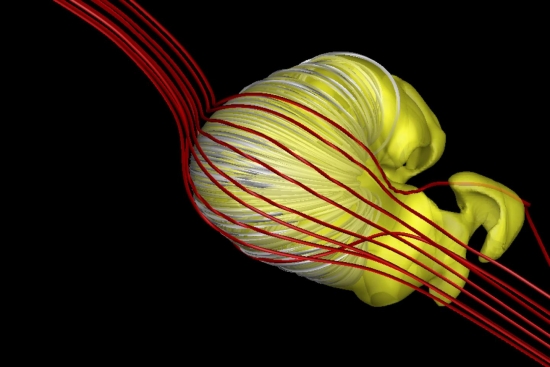
And let’s contrast this with the older view, at the left in this figure from the paper. In the caption, the reference to ‘case B’ notes one of two cases run in the scientists’ model, based on the fact that the interstellar magnetic field strength and direction are not well constrained (another reason for a properly instrumented probe in this region). For more on the distinction between the two cases, see the paper (citation below).
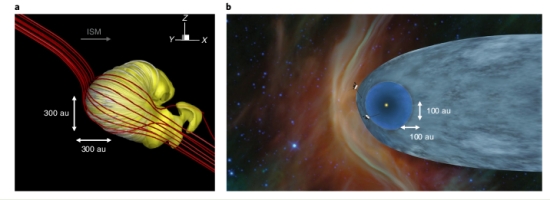
Image: This is Figure 4 from the paper. Caption: The new heliosphere. a, The HP [heliopause] is shown by the yellow surface (case B) defined by a solar wind density of 0.005 cm?3. The white lines represent the solar magnetic field. The red lines represent the interstellar magnetic field. b, The standard view of a comet long tail extending thousands of astronomical units. V1 and V2 are shown in this artist rendition; V2 has now passed the HP. The yellow dot represents the Sun. The supersonic solar wind region is represented by the blue region around the Sun. The extended region beyond the blue region represents the HS [heliosheath]. Credit: NASA/JPL-Caltech / Opher et al.
The authors describe the heliosphere’s shape as:
…a more ‘squishable’ heliosphere that has a smaller and rounder shape (Fig. 4a). This global structure is drastically different from the standard picture of a long heliosphere with a comet-like tail that extends to thousands of astronomical units (Fig. 4b). The distance from the Sun to the HP in the new round heliosphere is nearly the same in all directions.
Building a spacecraft like the APL Interstellar Probe would allow us to put instruments specifically designed for operating in this environment into play, among other things detecting pickup ions near the heliopause. This will further refine the heliosphere’s shape and also allow us to better compare our own heliosphere with those around other stars. There are astrobiological implications here, for the heliosphere deflects charged particles that could disrupt DNA. How interstellar particles enter stellar systems could thus play a role in evolution.
The paper is Opher et al., “A small and round heliosphere suggested by magnetohydrodynamic modelling of pick-up ions,” Nature Astronomy 16 March 2020 (abstract).

Ryugu’s Clues to the Early Solar System
Asteroid 162173 Ryugu, recently explored in depth by the Hayabusa2 spacecraft, is a C-type asteroid, rich in carbon. About a kilometer in diameter, it is evidently composed of highly porous material, and seems to have been formed by the agglomeration of fragments from a larger parent body that was broken apart by impacts. We learn this from a new paper in Nature that examines the object’s high porosity and the significantly low mechanical strength of its rock fragments, which affect how it would act if hitting an atmosphere.
Matthias Grott, of the German Aerospace Center (Deutsches Zentrum für Luft- und Raumfahrt; DLR) is the principal investigator for MARA, the DLR-built radiometer that flew on board Hayabusa2 and landed aboard the Mobile Asteroid Surface Scout (MASCOT). Says Grott:
“The published results are a confirmation of the results from the studies by the DLR radiometer MARA… It has now been shown that the rock analysed by MARA is typical for the entire surface of the asteroid. This also confirms that fragments of the common C-type asteroids like Ryugu probably break up easily due to low internal strength when entering Earth’s atmosphere.”
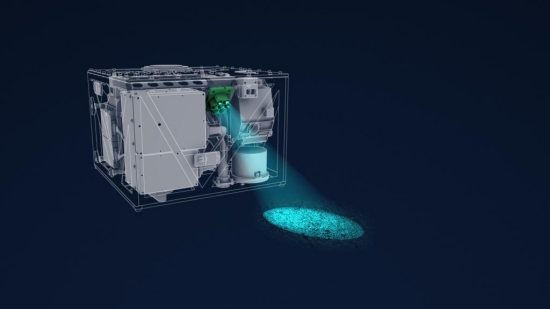
Image: An artist’s conception of the MARA radiometer at work within MASCOT on the surface of Ryugu. Credit: DLR.
Breaking up into fragments upon entering Earth’s atmosphere would help to explain why carbon-rich meteorites are relatively uncommon on Earth, as most would have burned up on the way to the ground. But the new paper goes on to make the case that fragile, porous asteroids like this may link us directly to the evolution of primordial dust into planetary bodies. Hence the importance of missions like Hayabusa2 and OSIRIS-REx, which actually visit and sample the minor objects that would have formed during the earliest era of the Solar System’s development.
The paper in Nature looks at the global properties of Ryugu, an analysis that complements and confirms the findings of the MASCOT lander. The asteroid’s surface temperature has been examined through the Thermal Infrared Imager (TIR) aboard the spacecraft by the team working with first author Tatsuaki Okada of the Japanese space agency JAXA. Measuring in the 8 to 12 micrometer wavelength range during day and night cycles, they find a surface that heats quickly when exposed to sunlight. Grott adds:
“The rapid warming after sunrise, from approximately minus 43 degrees Celsius to plus 27 degrees Celsius suggests that the constituent pieces of the asteroid have both low density and high porosity.”
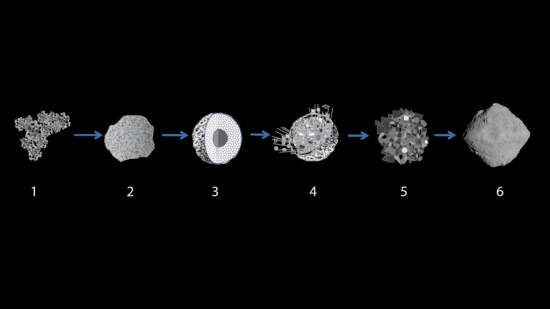
Image: Formation scenario for Ryugu. Credit: Okada et al.
We should be learning a lot more when the surface samples from two landing sites, currently traveling back to Earth with the spacecraft, land in Australia at the end of this year. The paper draws not only on already acquired surface data but high resolution mapping from orbit. The authors argue that C-type asteroids are most likely formed from ‘fluffy dust’ or pebbles in the early Solar System, leading to large asteroids in the main belt with high porosity. Further thoughts re planet formation from the paper:
These C-type asteroids might share their highly porous nature with planetesimals that formed from fluffy dust in the early Solar System and could have strongly affected planetary formation processes such as cratering and collisional fragmentation by attenuating shock propagation . The possibility still cannot be ruled out that Ryugu’s low thermal inertia and low density arise from surface materials different from carbonaceous chondrites, such as the organic- rich material discovered on comet 67P/Churymov-Gerasimenko . This question will, however, be resolved upon sample return.
What the samples will reveal, then, is whether Ryugu is made up of material similar to chondritic meteorites — chondrules are millimeter-sized spheres of rock considered to be building blocks of planet formation — or organic-rich material like that found on comet 67P/ Churyumov-Gerasimenko. We’ll have that answer comparatively soon, but there is something else to look forward to when it comes to probing exotic materials: The sample returns from the OSIRIS-REx mission at asteroid Bennu, expected in 2023, and samples of Phobos and Deimos. The latter should reach us in 2029 as JAXA explores the asteroid-like Martian moons in the ‘Martian Moons eXploration’ (MMX) mission, scheduled for launch in 2024.
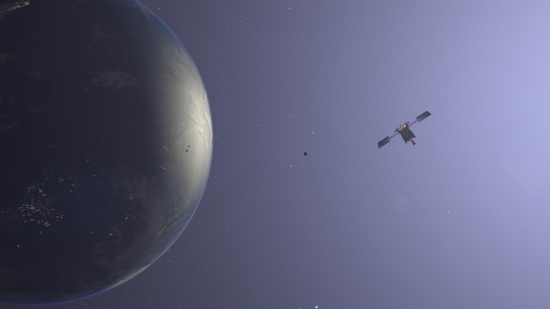
Image: Artist’s conception of Hayabusa2 nearing the Earth for sample return. Credit: DLR.
The paper is Okada et al., “Highly porous nature of a primitive asteroid revealed by thermal imaging,” published online by Nature 16 March 2020 (abstract).

Extending the Hunt for Trans-Neptunian Objects
316 Trans-Neptunian Objects (TNOs) have turned up in a new analysis of data from the Dark Energy Survey, 139 of these being new objects that have not been previously published in the literature. With roughly 3,000 TNOs known, the catalog from this work represents a healthy 10 percent of the total, but more significantly, extends and fine-tunes our methods for tracking such objects.
Trans-Neptunian Objects, of which Pluto/Charon represents the best known, orbit beyond Neptune, with Kuiper Belt Objects being a sub-category existing between 30 and 55 AU from the Sun. Here the population is thought to be in the tens of thousands when restricting the definition by size to objects at least 100 kilometers across. But to these Kuiper Belt objects we can add the population of so-called Scattered Disk Objects, which exist in eccentric and inclined orbits, the more extreme of these with semi-major axes between 150 and 250 AU (and then there’s Sedna, with aphelion now estimated at more than 900 AU).
Carly Howett’s excellent overview of TNOs from the Southwest Research Institute (Boulder, CO) explains their wide-range and is highly recommended. For now, let’s focus on the DES dataset and the catalog that is growing out of it. The Dark Energy Survey wasn’t created to be a hunter of minor planets but rather an attempt to map hundreds of millions of galaxies while detecting supernovae in the thousands, the idea being to find patterns of cosmic structure that may give us insights into the ‘dark energy’ that seems to be accelerating the universe’s expansion.
DES is an international effort, with over 400 scientists from 25 institutions around the world using data collected by a highly sensitive 570-megapixel digital camera called DECam that is mounted on the Blanco 4-meter telescope at Cerro Tololo Inter-American Observatory in the Chilean Andes. Between 2013 and January of 2020, the collaboration carried out a wide-area survey, imaging 5000 square degrees of the southern sky in five optical filters.
Out of these high precision images came the opportunity seized by the University of Pennsylvania researchers to search for new objects beyond Neptune. University of Pennsylvania graduate student Pedro Bernardinelli, lead author of the paper on this work, saw the opportunity presented by the DES dataset:
“Dedicated TNO surveys have a way of seeing the object move, and it’s easy to track them down. One of the key things we did in this paper was figure out a way to recover those movements [in the DES dataset].”
Exactly so. What Bernardinelli and team had to construct was a methodology that could tackle deep-sky DES data and apply them to the TNO question. Unlike DES, TNO surveys generally take measurements as frequently as hourly, allowing astronomers to track object movements against the background field. Adapting DES data was a challenge. Working with the first four years of the DES images, Bernardinelli extracted an initial dataset of 7 billion ‘dots’ that represented objects detected by his software above the background levels of the images.
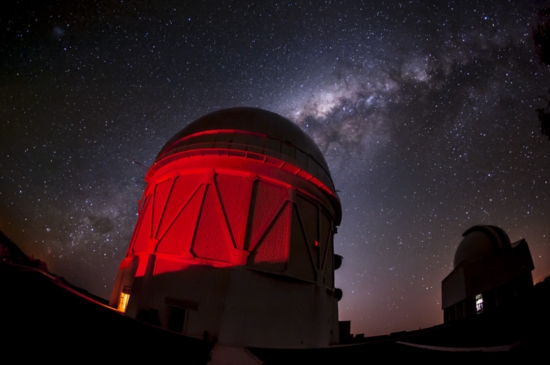
Image: The Blanco Telescope dome at the Cerro Tololo Inter-American Observatory in Chile, where the Dark Energy Camera used for the recently completed Dark Energy Survey was housed. Credit: Reidar Hahn, Fermilab.
The researcher was able to build a ‘transient’ list of 22 million objects by culling out stars, galaxies and supernovae; he then began looking for movement on successive nights. 400 candidates emerged out of the 22 million-object field, all of them seen over at least six nights of observation and subsequently subjected to filtering and verification. The latter involved going back to the original dataset to see if more images of the object in question could be located.
Previously known TNOs were likewise useful, their location examined for 25 different nights as the researchers gathered information that helped them adjust their models. Stacking multiple images helped to confirm an object’s TNO status, while injecting fake objects into the analysis served as a check on how the methods handled them. The 316 TNOs isolated by this period of development and analysis revealed objects from 30 to 90 times Earth’s distance from the Sun.
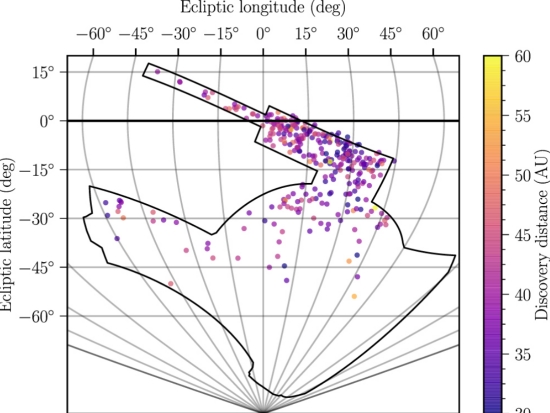
Image: The location of the objects found in the first four years of DES data. The outline shows DES’s search range and the color of each dot shows how far away the object is in astronomical units. Two of the detections were more than 90 AU, or almost 13 billion kilometers away. Credit: Pedro Bernardinelli.
Ahead for this team is an analysis incorporating the last two years of the DES dataset, with a lower threshold for object detection at the first filtering stage. As many as 500 new TNOs, the researchers estimate, may turn up in this work. The hope is that the programs the team has developed will now be useful when applied to other large datasets in the future. Remember that the orbits of the various categories of TNO help us to analyze as yet unseen objects beyond Pluto’s orbit that may include the hypothesized ‘Planet Nine,’ so the more TNOs, the better.
The paper is Bernardinelli et al., “Trans-Neptunian Objects Found in the First Four Years of the Dark Energy Survey,” The Astrophysical Journal Supplement Series Vol. 247, No. 1 (10 March 2020). Abstract.

An Unusual Look at Mercury
Centauri Dreams rarely looks at Mercury, the operative method being generally to focus on the outer Solar System and beyond. But a new paper out of the Planetary Science Institute in Tucson (AZ) raises the eyebrows in suggesting that parts of Mercury may once have been able to shelter prebiotic chemistry and perhaps, according to the authors, even primitive life forms. Such a finding might thus extend our ideas of ‘habitable zones’ much closer to parent stars than previously assumed.
It seems a long shot, given surface temperatures reaching 430? in the daytime and -180? at night, but the PSI work turns up interesting possibilities in some subsurface regions of Mercury. The heart of this research is found in the datasets returned by the MESSENGER (MErcury Surface Space ENvironment GEochemistry and Ranging) spacecraft. The Mercury orbiter identified numerous volatile-bearing surfaces on Mercury, with high abundances of sulfur, chlorine and potassium, and polar ice in permanently shadowed craters at the planet’s poles.
Key to the research are Mercury’s ‘chaotic’ terrains, hilly and fractured areas first seen in 1974 in the flybys of Mariner 10. The planet’s spectacular Caloris Basin is a crater about 1525 kilometers across ringed by mile-high mountains. Interestingly, numerous chaotic terrains are found directly on the other side of the planet from the Caloris Basin, leading to the theory that the impact produced them. The new paper finds that idea unconvincing. Instead, the chaotic terrains seem to have formed through gradual developments of a non-catastrophic nature. From the paper:
We attribute the immense volume losses, which we infer to have occurred during chaotic terrain formation… to widespread collapse associated with the devolatilization of hundreds of meters to a few kilometers of upper crustal materials. In the context of this hypothesis, we define “collapse” as encompassing elevation losses due to (1) mass wasting associated with the sublimation of surface/near-surface volatiles and (2) gravity-driven terrain disintegration over zones of deep volatile evacuation.
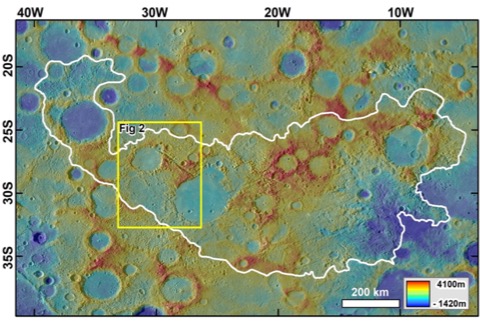
Image: Extent of a vast chaotic terrain (white outline) at the antipode of the Caloris basin (~5 x 105 km2). Credit: Rodriguez et al.
In other words, no impact needed. The authors note that the chaotic terrain is not geographically limited to the Caloris antipode, suggesting that the volatile-rich crust may have been global. They also find that the antipodal area experienced an active phase about 1.8 billion years ago for reasons unknown. The paper identifies large areas of surface elevation losses within the antipodal chaotic terrains, a finding the authors interpret as the result of crustal volatiles turning into gas and escaping from Mercury’s upper crust over an area of about 500,000 square kilometers.
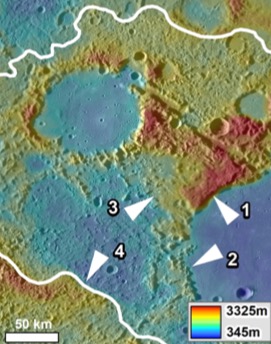
Daniel Berman (Planetary Science Institute) is a co-author of the paper:
“The deep valleys and enormous mountains that now characterize the chaotic terrains were once part of volatile-rich geologic deposits a few kilometers deep, and do not consist of ancient cratered surfaces that were seismically disturbed due to the formation of Mercury’s Caloris impact basin on the opposite side of the planet, as some scientists had speculated. A key to the discovery was the finding that the development of the chaotic terrains persisted until approximately 1.8 billion years ago, 2 billion years after the Caloris basin formed.”
Image: Zoom in showing variable magnitudes of collapse, which includes a relatively unmodified rim section that is smooth but not broken into knobs (arrow 1). This area adjoins another part of the rim that has been almost entirely removed (arrow 2). The adjacent intercrater regions also exhibit deep and abrupt relief losses (arrows 3 & 4). Credit: Rodriguez et al.
Where did this volatile-rich crust come from? One possibility is impacts from outer Solar System objects or perhaps main belt asteroids. Another is outgassing of volatiles from the interior. PSI’s Jeff Kargel, likewise a co-author, makes this interesting point:
“We also observe evidence of surficial devolatilization, probably caused by solar heating. If so, we have an opportunity to infer the range of Mercury’s volatile properties and compositions… While not all volatiles make for habitability, water ice can if temperatures are right. Some of Mercury’s other volatiles may have added to the characteristics of a former aqueous niche. Even if habitable conditions existed only briefly, relics of prebiotic chemistry or rudimentary life still might exist in the chaotic terrains.”
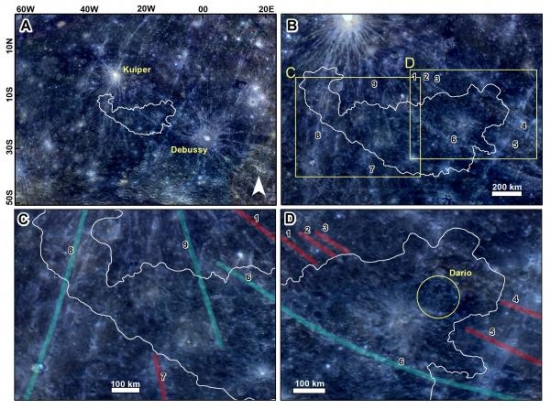
Image: Context view showing the location and extent of the chaotic terrain antipodal to the Caloris basin (outlined in white) relative to the ray systems of the Kuiper and Debussy impact craters. (B) Close-up view of panel A that provides the context and locations for panels C and D. The numbers 1-9 identify individual rays within the region’s view. (C, D) Close-up view showing crater rays that extend over the chaotic terrain (green lines 6, 8, 9) and other crater rays that appear truncated over the chaotic terrain (red lines 1-5, 7). We provide the location of the hollow hosting crater Dario in panel C. Credit: Rodriguez et al.
That volatile losses may not all be ancient is inferred from the fact that crater ejecta rays are not found in extensive areas of the chaotic terrain, which the authors interpret as indicating more recent activity. Mercury’s ‘hollows’ — small depressions resembling melt pits in terrestrial permafrost — have likewise been investigated as signs of near-surface volatile losses, although the matter is still under investigation. Whatever the case, it’s apparent that MESSENGER has returned enough information to offer up a first round of potential landing sites to investigate the planet’s volatile-rich crust and conceivably study its unexplored potential for astrobiology.
The paper is Rodriguez et al., “The Chaotic Terrains of Mercury Reveal a History of Planetary Volatile Retention and Loss in the Innermost Solar System,” Scientific Reports 10, Article number: 4737 (2020). Full text.


